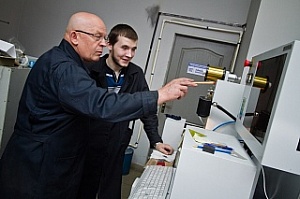A team of the TSU Laboratory of High-Strength Crystal Physics is creating highly entropic alloys that differ in the unusual structure of the crystal lattice. They provide new materials with mechanical characteristics that make them suitable for use in the extreme conditions of space and the Arctic - at high and low temperatures, under load, and when exposed to radiation.
The object of the physicists’ study is the high-entropy alloys FeNiCoCr (+ Al, TiAl and Mo). Compounds with this chemical composition are used only in the polycrystalline state. The laboratory staff, led by its head Yury Chumlyakov, was the first in the world to grow single crystals and strengthen them with nanoparticles. At present, the physicists are studying the microstructure, deformation mechanisms, and mechanical properties of the single crystals obtained.
- High-entropy alloys (HEAs) are a new class of compounds, the design of which is not based on adding a small amount of metal to one base element (for example, bronze is copper with the addition of tin), but on mixing many metals in approximately equal amounts, - explains Irina Kireeva, the head of the project, an member of the Laboratory of High-Strength Crystal Physics. - In the case of highly entropic alloys, the atoms of various elements are arranged arbitrarily in the lattice, which means these are disordered alloys.
Such alloys usually consist of five or more components. All atoms have the same probability of being located in a specific lattice site. The presence of heterogeneous atoms of elements with different sizes leads to a significant distortion of the crystal lattice and difficulty in diffusion, which in turn ensures the growth of strength properties and their stability over a wide temperature range.
The unique structure provides the highly entropic alloy with a whole range of important operational characteristics, such as hardness, wear resistance, oxidation and corrosion resistance, and high thermal stability compared to traditional materials. These properties make it possible widespread use of the alloy in wind power plants in extreme temperature conditions below 120 K (-153 ° C) (cryogenic temperatures).
- Special attention in the project will be paid to the microstructure of the HEAs of FeNiCoCr (+ Al, TiAl and Mo), says Irina Kireeva. - Due to changes in the microstructure, namely, the selection of nanosized particles, the operating temperature range of the material will be expanded, which will help it operate not only at low temperatures but also in the high-temperature mode - up to + 700 °С.
The research results of TSU physicists will serve as the scientific basis for the creation of new structural and functional materials based on wind farms adapted for space and suitable for the manufacture of structures in the Arctic. Thin films from HEAs can be used as protective coatings and thermal barriers.
According to the developers, the promising properties of high-entropy alloys make them potentially suitable for use as tools, molds, dies, mechanical parts, and furnaces that require high strength, heat resistance, and resistance to oxidation and wear[OU1]. They also have excellent corrosion resistance and can be used in chemical plants and foundries and even as parts for pumps operating in seawater.

